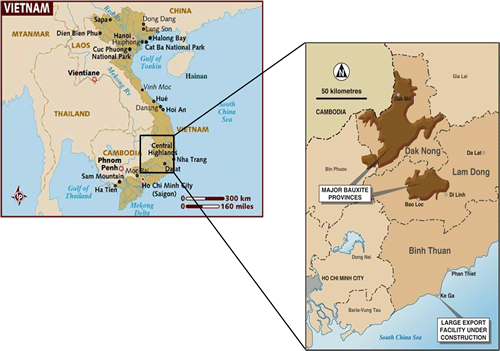Country Overview
Background
Atlantic believes there is a strong business opportunity in the resources sector in Vietnam particularly in the aluminium sector. Our experience to date in dealing with various interested groups in Vietnam has been particularly positive. Atlantic looks forward to building closer relationships in Vietnam in the future.
Vietnam has a competitive advantage in the aluminum supply chain given the extensive and high quality gibbsite ore deposits typically found in the Central Highlands region and the country’s proximity to major world demand centres.
Vietnam’s Central Highlands host the world’s third largest bauxite deposits containing an estimated 5.4 billion tonnes of high quality gibbsite bauxite. These have developed as a result of prolonged tropical weathering of Quarternary flood basalts that inundated an area of about 21,000 square kilometers (km²) during the Pliocene-Pleistocene, and now form an area of extensive dissected plateau 100m to 1,000m above sea level (Figure 1).
A key characteristic of the bauxite is that it is amenable to upgrading by simple washing and screening to recover an alumina-rich, silica-depleted concentrate suitable for export or for refining on-site. The deposits were discovered in the late 1970s, with little exploration conducted since then as efforts have been concentrated on finding a means to develop them. The combination of lack of transport and other industrial infrastructure in the region, and the high capital cost has so far precluded commercial-scale development. The deposits are all owned by the State, and any development will most likely have to proceed in joint venture with a State owned enterprise (SOE).

Figure 1 - Location of bauxite deposits in Lam Dong and Dak Nong Provinces
Mining in Vietnam
Vietnam is a one-party state, with ultimate political power held by the Communist Party of Vietnam (CPV).
The Vietnamese legal system is based on communist legal theory and French civil law.
The mining industry plays a very important role in Vietnam’s economy with minerals accounting for a large share of exports. In 2008, the output of the mining industry, not including natural gas, was estimated at VND 23.54 trillion, accounting for 3.61% of GDP. Major mineral commodity exports in 2008 were crude oil (US$ 10.45B) and coal (US$ 1.44B).
Vietnamese mining law is based upon a licensing system with licences being granted to investors who can demonstrate an appropriate financial and technical capability. The law provides for three tenement types:
- Prospecting Permits (PP) - These have a maximum area of 2,000km2 and are of one year duration, although they can be extended for a second year. A PP is non-exclusive and non-transferable.
- Exploration Licenses (EL): A company may apply for a maximum of five licences, each of 50km2 for precious metals and gems, or 100km2 for non-precious metals, non-metallic minerals and coal. Licences are valid for two years with two one-year extensions allowed, each accompanied by a 30% reduction in area.
- Mining Licences (ML): All Mining Licences have a duration of 30 years and are extendable for another 20 years. There is no exclusive fee or land rental for MLs. The holder of an EL has the exclusive right to apply for a ML over the same area as held under the EL.
In most Joint Ventures, the Vietnamese partner’s contribution to the project’s Investment Capital will include the project’s Land Use Rights. In practice, the government has often subsidised State-owned companies by allocating the Land Use Rights at a low price which are then contributed to the Joint Venture at market prices.
The corporate tax rate for foreign investors in mining is 28%, as for any other foreign investment enterprise. A two year tax-free holiday followed by two years at half tax are commonly offered within the framework of a Foreign Investment Licence.
Royalties are payable at varying rates on minerals produced, generally ranging from 2% to 5%, but as high as 8% for diamonds and precious stones. The rate for bauxite is the same as for base metals, that is, 3%. A royalty rate for alumina has not been declared. A Foreign Investment Licence may provide for preferential royalty rates and/or exemptions.